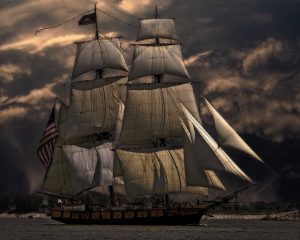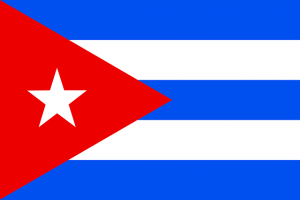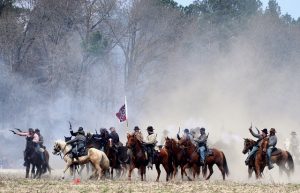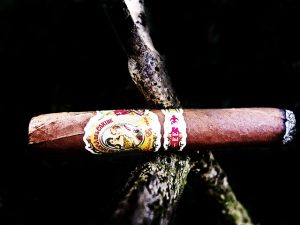The Complete History of the Cigar
The Cigar. A tightly rolled wrap that consists of both fermented and dried tobacco leaf, which comes in various shapes and sizes. The cigar is an elegant and old-fashioned celebratory item that has been smoked since 1492. The history of the cigar is rich and detailed, and features many different accounts of what really happened. Overall, the?various differentiations of the historical account of the cigar has not severely impacted the common understanding of it's history.
The Beginning
In the year 1492 Christopher Columbus sailed the ocean blue (I'm sure you learned this in your elementary school class at some point). When Columbus was sailing the ocean blue he landed in what many claim to be Cuba and other's claim to be some random Central American country. Either way, society sees?cigar history beginning with the Mayans.
The Mayans

met Columbus on the shores and quickly introduced him to their abundant and lively crop known as tobacco. He soon was shown how to use this crop: to smoke it.?Columbus took a strong liking to this crop he discovered in the New World and figured that he should bring it back to his home country, Spain, which is part of the Old World. Columbus eventually returned to Spain and introduced the new crop to both King Ferdinand II and Queen Isabella. This was the first sign of expansion of the newly discovered crop, which ultimately led to the cigar.
Cuba's Impact on Globalizing the Cigar
When Columbus came into contact with the Cuban natives, also known as the Tanio, they were the only ones who were educated enough in the subject of tobacco to know how to roll it. Columbus's discovery in Cuba exploited Spain in terms of the quality of tobacco and cigars that Spain?produced. It proved that Cuba's cigars were choice.

A reason that Cuba's cigars were premium in terms of quality was because of the fertile land and the specific climate that they had. Both the land and the climate allowed all three types of tobacco leaves used in a cigar to thrive; this includes the wrapper, binder, and filler. Soon word had spread all across the Old World that Cuba was a gold mine for cigars, which promoted heavy trading between Europe and Asia. Ships would sail to Cuba, pick up tobacco, and then trade it to Asia, or vice-versa.?Cuba's initial impact on the cigar industry in the 15th century has been everlasting, and continues to help solidify Cuba as a perennial power in the cigar industry even to this day.
Cigars in the 1800's
The 1800's?was the first time the cigar became?commercialized. The mid to late 19th century was the apex of cigar popularity. Somewhere between 120 and 130 private New York City apartments were running home cigar manufacturing businesses. The Civil War was also a big factor of the 19th century that contributed to the commercialization of the cigar. During this time most cigars were made up of American wrappers and Cuban fillers. The Civil War Era (1861-1865) is known to many?cigar history buffs as the Golden Age of Cigars. People call it that because it was the time in American history when the government began to make rules for cigar makers. A high demand and government

involvement shows the cigar's?incremental rise in the free market. These rules consisted of things such as number of cigars per box, type of boxes, notices, warnings, taxes, and licenses.
The Golden Age of Cigars also extends to England. During the 1960's, the wooden mold cigar was invented in England; this was a revolutionary creation. After this innovation, England did not stop pushing the boundaries of the cigar. The English also created rings for the cigar. In the modern day these are called bands. Most?companies have preset bands, but?speciality companies such as
Custom Tobacco allow you to customize your band with anything you like. This ranges from your full last name, to aesthetic designs, and even holiday themes. Customizable companies such as Custom Tobacco also allow you to pick any blend and wrapper of your choice.
The 1800's was a time for innovation and experimentation in the cigar world, this allowed the tobacco industry to thrive and develop its mark in society, which helped cigars gain success in the years to come.
Cigars in the Early 1900's
Production, production, production. Even though the Industrial Revolution took?place 70 some odd years before 1900, the 20th century was the industrial revolution in terms of cigars. Technology was still advancing?at a high rate in the United States (before the Depression), which helped cigars become mass produced. Every US factory was producing on average 4,000 boxes of cigars a year, but there were 27,366 factories in the US. The most efficient factory was pumping out cigars like a hose pumps out water. This cigar factory produced 20,000 cigars per day. In 20th century United States, many cities were still developing, but a city that was strongly established was the Big Apple, New York City.
New York City was the leader in cigar manufacturing because of the beast of the five boroughs: Manhattan.?Manhattan had by far the highest concentration of cigar manufacturing facilities than anywhere else in the world. It consisted of an area that was 2 1/2 miles long and 3/4 miles wide. Manhattan during the early 1900's produced more cigars than forty-five states combined, including?Florida. New York City during the 20th century did not only have the most cigar factories but they also had the most ethnic diversity in terms of cigar makers. 33%?were German, 30%?were Bohemian, 20%?were Russian-jews, and 17% identified as "other."

The early 1900's were also looked at as a transitional period in tobacco?history. It was because this marked a new leader in the industry. The United States documented having sixty varieties of cigar tobacco, juxtaposed to the previous industry leader, Cuba, who documented fifty varieties of cigar tobacco.
The 1920's
1920 was?the peak year of the cigar industry in the 20th century. 1920 was the biggest year for cigar production. This high rate of production is thanks to the fact that the United States simmered down on importing cigars from Cuba; only 7.5% percent of cigars were imported from there during this year. The rest were homegrown and rolled on American soil. During 1920, America also became very suave in the way they used the word "Havana" on the cigar. Most cigar buyers at the time, and to this day, think that, that word implies the cigar is from Cuba. Believe it or not the word "Havana" imprinted on the cigar is really referring to the US domestic tobacco called "Havana see."
Although the Civil War Era is predominantly looked at as the Golden Age of cigars, the early 1900's also contributes to its rich history in various and extensive ways. Without the factory workhorses in Manhattan, or the ethnically diverse cigar makers, the history of cigars may have been brutally altered and may have gone down a different path.
Cigars in the Mid to Late 1900's
Cuba made a big statement during this time period. Fidel Castro came to power in 1959 after?President Fulgencio Batista fled the country; this was pivotal for the cigar at an international stage. Because Castro decided to nationalize the cohiba cigar it became exclusively available to Cuban citizens.

The cohiba cigar, at the time, was an international favorite. Castro turned the cohiba cigar into a brand, allowing him to nationalize it. Although Castro nationalized the brand, it did not stop Cuban cigar makers from profiting internationally. Many Cuban cigar makers fled the country and migrated to nearby countries, such as the Bahamas, Dominican Republic, Honduras, and Mexico. This allowed these masters at their craft to keep on working for a profit. People viewed fleeing as positive for refugees?because they were still able to sell cigars to Americans despite the Embargo Act.
Eventually in 1982 the COHIBA cigar brand became released to the public. This helped inspire a boom in the cigar business similar?to the one that was experienced in the early 1920's. Part of this boom owes a big thanks to Habanos S.A. This company was created to control the sale and distribution of Cuban tobacco products worldwide. Over time the tobacco industry leader seems to fluctuate between Cuba and America. Still, no matter who the top dog is, stogie Joe's always?seem to find their way to be smoked by people worldwide.
Cigars in the Modern Day
In the Modern Era (2000 - Present) the cigar has adopted a personality, and has stayed true to it. It's modern personality is classy, subtle, and delighted. The cigar is something frequently smoked during this day an age either as a celebratory item, or for stylish purposes. While these are not the only reasons, they are the most popular.?

"Celebratory,"?may sound somewhat confined to only a few things; but that is wrong. In terms of celebratory that includes golf outings, getting drinks at the bar, business meetings, and parties. Cigars acted as a social mechanism similarly to alcohol. Stylistically, the cigar is mostly associated with suits and ties, and dresses and heels.?Formal and mature dress have begun to associate itself with the classy cigar. Next time you're thinking about asking someone for a drink you might as well say, "hey (insert name), want to smoke a stogie."

 met Columbus on the shores and quickly introduced him to their abundant and lively crop known as tobacco. He soon was shown how to use this crop: to smoke it.?Columbus took a strong liking to this crop he discovered in the New World and figured that he should bring it back to his home country, Spain, which is part of the Old World. Columbus eventually returned to Spain and introduced the new crop to both King Ferdinand II and Queen Isabella. This was the first sign of expansion of the newly discovered crop, which ultimately led to the cigar.
met Columbus on the shores and quickly introduced him to their abundant and lively crop known as tobacco. He soon was shown how to use this crop: to smoke it.?Columbus took a strong liking to this crop he discovered in the New World and figured that he should bring it back to his home country, Spain, which is part of the Old World. Columbus eventually returned to Spain and introduced the new crop to both King Ferdinand II and Queen Isabella. This was the first sign of expansion of the newly discovered crop, which ultimately led to the cigar.
 A reason that Cuba's cigars were premium in terms of quality was because of the fertile land and the specific climate that they had. Both the land and the climate allowed all three types of tobacco leaves used in a cigar to thrive; this includes the wrapper, binder, and filler. Soon word had spread all across the Old World that Cuba was a gold mine for cigars, which promoted heavy trading between Europe and Asia. Ships would sail to Cuba, pick up tobacco, and then trade it to Asia, or vice-versa.?Cuba's initial impact on the cigar industry in the 15th century has been everlasting, and continues to help solidify Cuba as a perennial power in the cigar industry even to this day.
A reason that Cuba's cigars were premium in terms of quality was because of the fertile land and the specific climate that they had. Both the land and the climate allowed all three types of tobacco leaves used in a cigar to thrive; this includes the wrapper, binder, and filler. Soon word had spread all across the Old World that Cuba was a gold mine for cigars, which promoted heavy trading between Europe and Asia. Ships would sail to Cuba, pick up tobacco, and then trade it to Asia, or vice-versa.?Cuba's initial impact on the cigar industry in the 15th century has been everlasting, and continues to help solidify Cuba as a perennial power in the cigar industry even to this day.
 involvement shows the cigar's?incremental rise in the free market. These rules consisted of things such as number of cigars per box, type of boxes, notices, warnings, taxes, and licenses.
The Golden Age of Cigars also extends to England. During the 1960's, the wooden mold cigar was invented in England; this was a revolutionary creation. After this innovation, England did not stop pushing the boundaries of the cigar. The English also created rings for the cigar. In the modern day these are called bands. Most?companies have preset bands, but?speciality companies such as Custom Tobacco allow you to customize your band with anything you like. This ranges from your full last name, to aesthetic designs, and even holiday themes. Customizable companies such as Custom Tobacco also allow you to pick any blend and wrapper of your choice.
The 1800's was a time for innovation and experimentation in the cigar world, this allowed the tobacco industry to thrive and develop its mark in society, which helped cigars gain success in the years to come.
involvement shows the cigar's?incremental rise in the free market. These rules consisted of things such as number of cigars per box, type of boxes, notices, warnings, taxes, and licenses.
The Golden Age of Cigars also extends to England. During the 1960's, the wooden mold cigar was invented in England; this was a revolutionary creation. After this innovation, England did not stop pushing the boundaries of the cigar. The English also created rings for the cigar. In the modern day these are called bands. Most?companies have preset bands, but?speciality companies such as Custom Tobacco allow you to customize your band with anything you like. This ranges from your full last name, to aesthetic designs, and even holiday themes. Customizable companies such as Custom Tobacco also allow you to pick any blend and wrapper of your choice.
The 1800's was a time for innovation and experimentation in the cigar world, this allowed the tobacco industry to thrive and develop its mark in society, which helped cigars gain success in the years to come.
 The early 1900's were also looked at as a transitional period in tobacco?history. It was because this marked a new leader in the industry. The United States documented having sixty varieties of cigar tobacco, juxtaposed to the previous industry leader, Cuba, who documented fifty varieties of cigar tobacco.
The early 1900's were also looked at as a transitional period in tobacco?history. It was because this marked a new leader in the industry. The United States documented having sixty varieties of cigar tobacco, juxtaposed to the previous industry leader, Cuba, who documented fifty varieties of cigar tobacco.
 The cohiba cigar, at the time, was an international favorite. Castro turned the cohiba cigar into a brand, allowing him to nationalize it. Although Castro nationalized the brand, it did not stop Cuban cigar makers from profiting internationally. Many Cuban cigar makers fled the country and migrated to nearby countries, such as the Bahamas, Dominican Republic, Honduras, and Mexico. This allowed these masters at their craft to keep on working for a profit. People viewed fleeing as positive for refugees?because they were still able to sell cigars to Americans despite the Embargo Act.
Eventually in 1982 the COHIBA cigar brand became released to the public. This helped inspire a boom in the cigar business similar?to the one that was experienced in the early 1920's. Part of this boom owes a big thanks to Habanos S.A. This company was created to control the sale and distribution of Cuban tobacco products worldwide. Over time the tobacco industry leader seems to fluctuate between Cuba and America. Still, no matter who the top dog is, stogie Joe's always?seem to find their way to be smoked by people worldwide.
The cohiba cigar, at the time, was an international favorite. Castro turned the cohiba cigar into a brand, allowing him to nationalize it. Although Castro nationalized the brand, it did not stop Cuban cigar makers from profiting internationally. Many Cuban cigar makers fled the country and migrated to nearby countries, such as the Bahamas, Dominican Republic, Honduras, and Mexico. This allowed these masters at their craft to keep on working for a profit. People viewed fleeing as positive for refugees?because they were still able to sell cigars to Americans despite the Embargo Act.
Eventually in 1982 the COHIBA cigar brand became released to the public. This helped inspire a boom in the cigar business similar?to the one that was experienced in the early 1920's. Part of this boom owes a big thanks to Habanos S.A. This company was created to control the sale and distribution of Cuban tobacco products worldwide. Over time the tobacco industry leader seems to fluctuate between Cuba and America. Still, no matter who the top dog is, stogie Joe's always?seem to find their way to be smoked by people worldwide.
 "Celebratory,"?may sound somewhat confined to only a few things; but that is wrong. In terms of celebratory that includes golf outings, getting drinks at the bar, business meetings, and parties. Cigars acted as a social mechanism similarly to alcohol. Stylistically, the cigar is mostly associated with suits and ties, and dresses and heels.?Formal and mature dress have begun to associate itself with the classy cigar. Next time you're thinking about asking someone for a drink you might as well say, "hey (insert name), want to smoke a stogie."
"Celebratory,"?may sound somewhat confined to only a few things; but that is wrong. In terms of celebratory that includes golf outings, getting drinks at the bar, business meetings, and parties. Cigars acted as a social mechanism similarly to alcohol. Stylistically, the cigar is mostly associated with suits and ties, and dresses and heels.?Formal and mature dress have begun to associate itself with the classy cigar. Next time you're thinking about asking someone for a drink you might as well say, "hey (insert name), want to smoke a stogie."